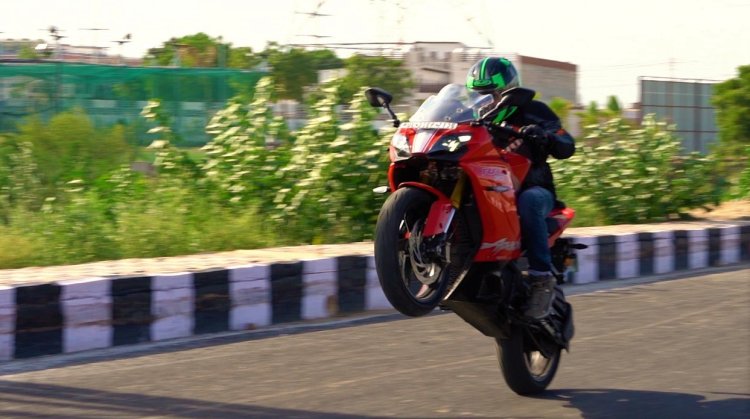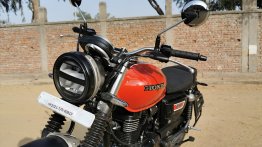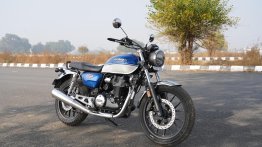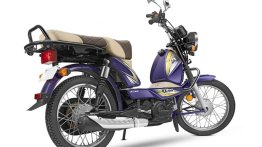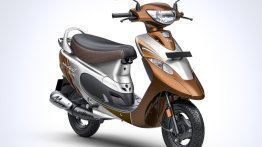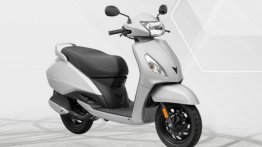In the year 2016, TVS showcased the Akula Concept to the attendees at the Auto Expo. It was said to be designed by taking inspiration from the Great White Shark. With the confluence of modern automotive design and Shark’s physique, the Akula concept looked sharp and shredded. In December 2017, when TVS launched the Apache RR 310 for the first time, it featured the same design theme as the Akula concept. Yes! TVS actually retained the design traits of the Akula in the Apache RR 310. However, it failed to offer the best-in-class riding experience, since it was marred by vibrations and hence, lacked finesse. Now, in 2020, TVS has updated the Apache RR 310 with a BS-6-compliant motor and a lot of other goodies as well. Apart from that, it now gets a slew of updates which come together to improve the overall riding experience of the Apache RR 310. Are these updates enough to mitigate all our complaints? Let's find out in this road test review.
TVS Apache RR 310 BS-6 Review – Styling & Build Quality
On the design front, TVS has not changed anything on the BS-6 version of the Apache RR 310. It continues to enjoy a generous road-presence with a gorgeous design that can be glared at all day long. The face continues to feature a twin-pod headlamp cluster with Bi-LED setup. The front fascia is quite a sight to behold and it is capable of lighting up the road, even in broad daylight. On either side, the shark-inspired silhouette reminds you of the Akula.
While the chunky tail-like exhaust muffler on the right, does so as well. In its Racing Red paint scheme, it is really hard to find any distinction between the BS-4 and BS-6 compliant models. However, the new Titanium Black is exclusive to the BS-6 model.
Another important change on the updated Apache RR 310 is the addition of a new 5-inch all-digital instrument cluster. It replaces the old back-lit LCD panel and uses a multi-colour TFT LCD instead. It continues to store, register and show a lot of data. It now also records 0-60 kmph time and lap time; along with retaining all the tell-tale data from the previous LCD unit. Users can now pair their mobile phones using the SmartXonnect feature. After syncing up with the TVS Connect smartphone app, they can get turn-by-turn navigation and call alerts on this display. Additionally, it also helps the rider to switch between four riding modes. Yes! The new instrument cluster is a much more modern unit compared to the basic console in the BS-4 model.
To operate this new unit, the switchgear on the left side of the handlebar has been redesigned. It now sports a plethora of buttons. Out of these, four are dedicated to the instrument console alone. The switchgear on the right-hand side has been updated as well. It now features just one rocker switch that operates the engine-kill function and also the thumb starter.
While the overall design remains the same, TVS has improved the overall fit and finish. The previous RR 310 was never shoddily designed, but there is a marked improvement when it comes to NVH. Along with that, the windscreen now gets a set of rubber mounts rather than sitting flush with the fairing. Even the mirrors now vibrate far less, offering a very stable and clear view of what’s behind. In our opinion, the design of the Apache RR 310 was extremely pleasing to begin with and TVS choosing not to fiddle with it is actually a bonus. However, as a part of the BS-6 update, the manufacturer has surely managed to address the NVH issue.
TVS Apache RR 310 BS-6 Review – Engine & Gearbox
As the name suggests, the fastest Apache on sale gets a 310 cc single-cylinder engine and it sits in a reverse-inclined fashion to save on space. Running on a compression ratio of 10.9:1, it puts out 34PS of peak power and 27.3Nm of max torque. The previous Apache RR 310’s motor was synonymous with vibrations but with the BS-6 unit, things are much smoother. The vibrations have been reduced while the power output remains untouched.
The moment you thumb the starter, the motor rumbles to life without any hiccups. It is loud and the exhaust note has quite a throaty character. To get going, using the clutch lever and gearbox is not a tough exercise either. Talking of the clutch first, it comes with slip-and-assist functions and does its job well. While downshifting, the assist function makes the task a glitch-free affair. On the other hand, if you tend to ride in a spirited manner and manage to fail matching the revs, its slip function helps resist any wheel hopping. The gearbox itself is smooth and precise, while its gear ratios help extract the best out of the engine in every situation. One can pull effortless wheelies in the first two gears, experience a strong power surge in the next two gears and choose to cruise all day long in the last two gears. All in all, a good mix for an everyday sports bike which has the chops to be a serious canyon carver.
The TVS Apache RR 310 lets you choose between a total of four riding modes – Rain, Urban, Sport and Track. In Rain and Urban mode, the peak power and torque figures are capped at 25.8 PS and 25 Nm, respectively. It also gets TVS’ Glide-Through-Traffic (GTT) function, where the rider can let off the clutch without any throttle input. The ECU controls the revs and ensures that the bike does not stall. It is a boon to use in traffic jams as it helps prevent fatigue in slow-moving conditions. In these modes, the engine's response is not restricted but delayed. While its top-end grunt is practically non-existent, the mid-range and low-range pack enough oomph to keep the rider excited. As a result, the top-speed in Rain and Urban mode is restricted to just 120kmph. In everyday use, Rain and Urban modes are sufficient for commuting in the city or even for touring on highways in torrential conditions.
The Sport and Track modes let you extract most of the Apache RR 310’s performance. All of its power and torque output of 34PS and 27.3Nm is available at the rider's discretion, while the top speed is limited to 160kmph. Not just that, the low-range and mid-range feel livelier riding in these two modes. In the higher-end of the rev range, the engine hardly feels stressed and that is a niggle which TVS has managed to remedy from the previous model. TVS claims a 0-60kmph time of less than 3 seconds, we managed to clock a faster time with a lighter rider on-board and going by the 0-60kmph timer provided with the instrument console.
When it comes to engine heat, temperatures are well controlled most of the time. However, riding hard on a bright sunny day or in city chaos can manage to make the rider’s legs feel some amount of heat. However, the air-channels work best on the move. Thus, as soon as the bike picks up some pace, the engine cools down quickly.
The 310 cc motor on the Apache RR 310 is a charmer for sure. It is rev-happy and its low-end torque manages to push you back when you wring the throttle in a hurry. While doing so, the ride-by-wire throttle ensures that all inputs are read precisely. While it loves to be ridden hard, it can easily transform into an effortless cruiser and chomp miles-after-miles at speeds of 100-120 kmph, all day long. Thanks to the BS-6 updates, the vibrations aren’t all that intrusive either. Talking of its fuel efficiency, it managed to return almost 30 kmpl in the city and 32 kmpl on the highway, despite my spirited right wrist. These figures, coupled to a small tank size of 11 litres, gives the Apache RR 310 a riding range of just 300 km. While this manages to be adequate for city commuting or track riding conditions, its riding range is the largest drawback for its touring credentials.
TVS Apache RR 310 BS-6 Review – Ride & Handling
In this department, despite the lack of upgrades, the 2020 Apache RR 310 scores better than the older model. Not much has been changed or tweaked on the motorcycle, and it continues to make do with the same chassis specifications, suspension components, brakes and rims. However, in its BS-6 avatar, TVS has shod the Apache RR 310's 17-inch rims with Michelin Road5 tyres. The front features a 110-section profile while the rear tyre features a 150-section profile. With the new tyres, grip levels are exceptionally improved on both wet and dry surfaces. The additional grip has also improved its braking performance.
To drop anchors, the Apache RR 310 uses a 300 mm petal-style disc rotor at the front and a 240 mm petal rotor at the rear. It gets dual-channel ABS, which is tuned differently for the four riding modes. In Rain and Urban modes, the ABS intervention is experienced earlier compared to Sport and Track modes. In the latter two, the ABS kicks only after locking the wheel a little. Experiencing this for the first time does feel a bit sketchy. However, after understanding the ABS’s reaction time, we chose to stick to just the Sport and Track modes.
Talking of its agility and handling, the Apache RR 310 is not the most flick-able bike in its segment. The KTM RC 390 still holds that title. However, the Apache RR 310 is definitely the most stable. Thanks to its wind tunnel-tested fairing, longer swing arm (a result of the reverse-inclined motor), and a kerb weight of 174 kilograms, it can hold its lines like a freight train. While the riding range is its biggest drawback when it comes to touring, the stability is its biggest plus point. Come rain or crosswinds, the Apache RTR 310 is not affected by either. Despite that, it can tip in in the corners with ease and trace the racing line effortlessly. These characteristics make the Apache RR 310 an easy bike to live with on an everyday basis. The new Michelin rubbers also help provide better grip in any corner-carving exercises.
The suspension duties are performed by 41 mm upside-down forks at the front and a mono-shock at the rear. These components have been sourced from Kayaba but are tuned by TVS itself. They are apt at offering a great balance between ride comfort and stability. With limited travel, the suspension is capable of absorbing the bumps and potholes with ease. While the rear mono-shock feels stiffer sprung at times, it is definitely not as back-breaking as the super-committed RC 390.
Talking about comfort, most would find the rider triangle to be on the easy-going side. While the footpegs are rear set, the clip-on bars are slightly raised. One neither sits up-straight with bent elbows nor does he/she sit in a fully-committed super sport-like riding position. It falls right in the sweet spot, but may not be everyone's cup of tea. The saddle height measures at 810 mm off the ground, which is considered to be on the taller side. To ensure that riders like me, who are vertically-challenged (with a height of 5’6”) can reach the ground, the seat has been narrowed-out around the tank. To add to its practicality, it gets a ground clearance of 180 mm, which ensures the Apache RR 310 goes over speed bumps of all kinds without scraping its belly.
TVS Apache RR 310 BS-6 Review - Verdict
On the whole, the Apache RR 310 has a very unique character. It can attack corners with ease, negotiate bumper-to-bumper traffic effortlessly and cruise down the open highways with no complaint. It not only looks good but also boasts high levels of fit and finish. While the engine is peppy, it certainly is a tad gruff, especially in top-end of the rev band. It vibrates, it stutters; but is certainly quite torquey. That being said, the Apache RR 310 feels Italian in more ways than it feels Indian. It packs in a lot of pros, yet can be forgiven for its cons given the VFM factor. With a price tag of INR 2.45 lakh (ex-showroom), it is priced right in our books. It even undercuts its biggest rival, the KTM RC 390 by INR 3,000 and the Kawasaki Ninja 300 by INR 53,000. While we do think that there is room for improvement with the Apache RR 310, that would also result in an increase in cost. With no doubt in our minds, we feel that the TVS Apache RR 310 is one of the best Indian-made motorcycles.
Photographs - Yatharth Singh Chauhan





